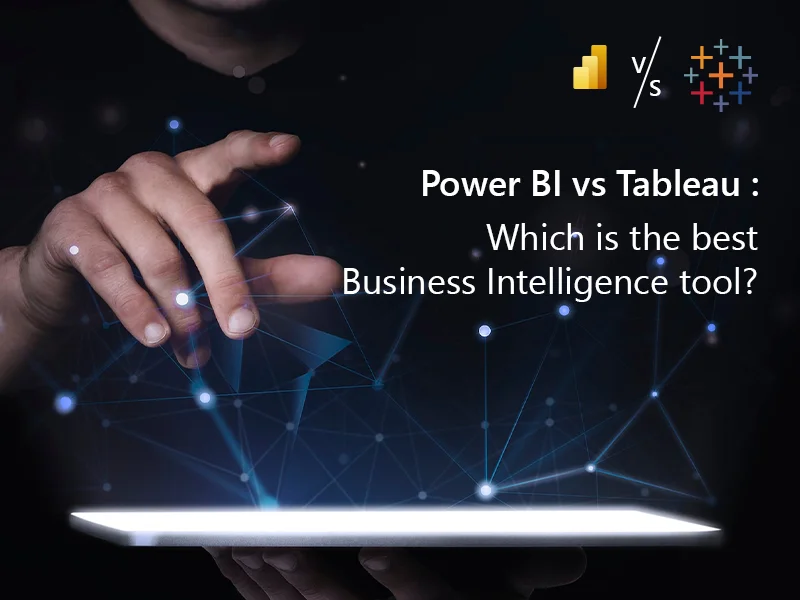Are you confused about selecting the perfect business intelligence tool for your business? If your reply is positive, you landed on the right place where we resolve your confusion regarding the necessary tools used for in-depth data analysis and help you to create interactive visual reports.
In the ever-changing technological world, every day, new key players are emerging in the field of data visualization and analytics. But there are buzzwords related to the two popular data analytics tools, Power BI, and Tableau, amongst the decision-makers and CTOs of organizations.
So, here, we will compare the two giants in the business intelligence sector, Power BI and Tableau, in every aspect. Our discussion regarding Power BI vs Tableau helps business decision-makers and data analytics experts to make an appropriate selection of the top business intelligence tool that makes data interpretation easier.
Productive comparison of business intelligence tools: Power BI vs Tableau
Power BI and Tableau are renowned names in the business intelligence and data visualization fields used in different industries. But it might be troublesome to include or integrate the advanced functionalities of data analytics tool into every business sector.
For example, small and medium-scale industries can efficiently utilize Power BI compared to Tableau due to the cost-effectiveness of Power BI. In contrast, Tableau is suitable for large enterprises where accurate and faster data analytics is the priority.
Now, we will enlist various functions of intelligent data visualization tools that help business decision-makers make a perfect selection based on their needs.
- Interactive Dashboard creation
- Power BI
Businesses can easily perform real-time data visualization with drag-and-drop functionalities using Power BI development services.
However, Power BI is much easier to learn and create interactive visual dashboards with seamless access to a large variety of data sets imported from multiple resources like SharePoint, Azure, Power Apps, and Microsoft 365.
Organizations can create customizable dashboards faster by integrating various essential data sources in Power BI. Indeed, this parameter makes Power BI the top business intelligence tool among data analyst experts.
- Tableau
Tableau is the best alternative for business intelligence functions for those organizations that require pure visualization of large data volumes. It delivers a more organized and clean approach to data sets but in less interactive and intuitive visual reports.
Tableau generates the data reports in a table-like interface, making it difficult to interpret data.
- Flexibility in Price
- Power BI
Power BI is the most cost-effective and affordable data visualization tool for companies that are habituated to the Microsoft ecosystem. Moreover, the services offered by Power BI are lower than Tableau, which is included in the monthly subscription plan of the M365 suite. There are two versions of the Power BI solution for your enterprise, the free version, and the premium version, which you can select based on your business needs.
- Tableau
The entire pricing structure of Tableau is expensive and more complex for various companies to understand and opt for its versatile business intelligence services. However, the total cost of services is divided into three categories, such as creators, explorers, and viewers, based on users.
Organizations can purchase the professional edition of Tableau to convert billions of data sets into interactive visuals with a great price range. Power BI is the cost-friendly option for small and medium-scale businesses compared to Tableau, which provides all the customizable data sets and visualization tools for creating engaging dashboards and reports.
- Data Capability
- Power BI
Enterprises can opt for Power BI, which handles the big data volume stored in any data storage resources like local drives and Azure cloud storage. It automatically fetches the data sets from the databases available on-premises and in the cloud.
- Tableau
In contrast, tableau manages and fetches the data based on the columnar approach in the table format using rows and columns. For instance, businesses require data visualization and interpretation from structured data sets using SQL databases.
- Data Shaping
- Power BI
Power BI can quickly and effortlessly execute data shaping after fetching the big data volume for creating interactive visual dashboards and reports. Businesses can use the power query editor that cleans the unnecessary data after processing and analysis that help executives view the report in an organized manner.
- Tableau
Enterprises find it a complex task to perform data shaping using Tableau because it involves a lengthy process to shape the large volume of data present in the table format.
- Data modelling
- Power BI
Data analysts and technical professionals can execute data modelling processes using the DAX and Power Pivot functions in Power BI. Moreover, these innovative and advanced data analytics functions are easily accessible to users.
- Tableau
Enterprises must follow the streamlined process to perform the data modelling process in Tableau. It is because there is the absence of specific data modelling function in Tableau.
Does Power BI is better than Tableau?
After the brief discussion and comparison of the essential components of Power BI and Tableau, it gives a picture-perfect understanding of both these data analytics tools to organizations. Power BI provides an excellent user interface that lets you drag and drop intuitive functions to craft engaging visual reports.
Tableau is a powerful tool for data interpretation, but it is more challenging for businesses to learn and use in their existing system. If you require all the necessary functions for precise data analysis, you can choose Power BI over Tableau based on your business needs.
Author:
Michael Donald is a senior IT Consultant at leading Power Bi Solution Provider, Bitscape. He has unified experience in adding value to the existing technological architecture of various businesses. During his professional journey, he has tackled a wide range of challenges and has built the ability to work through challenging issues in any industry.


